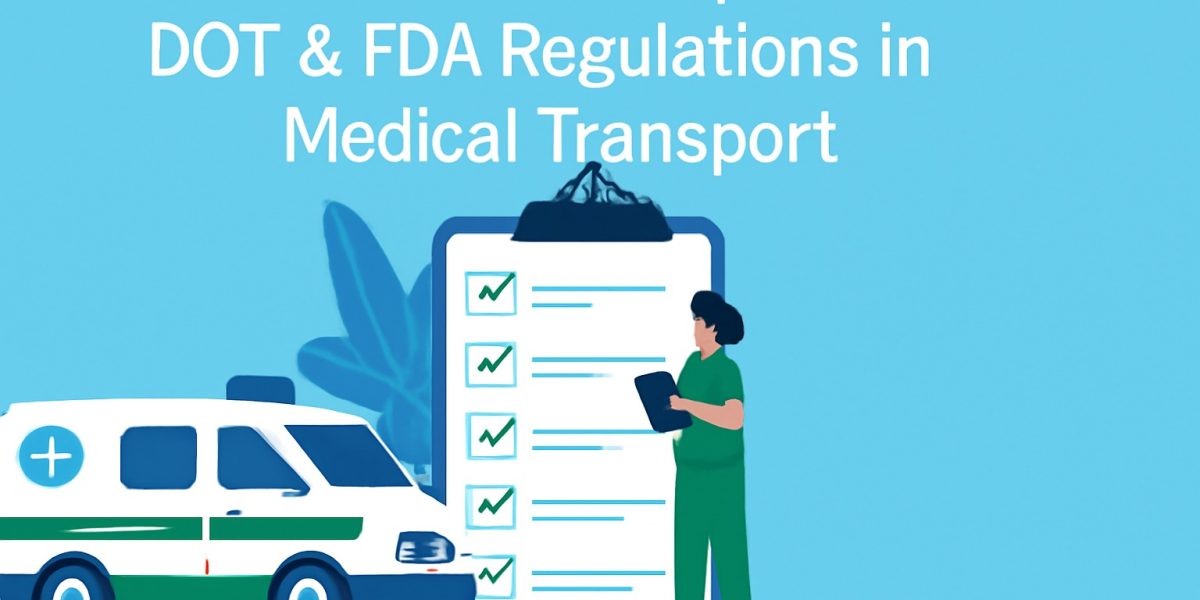The intersections of law, safety of patients, operational effectiveness, and patient safety dictate that medical transport service providers comply with relevant rules and regulations. Compliance in the case of advanced healthcare means ensuring appropriate control over the operations performed on patients who need specialised care. Such complete control requires gaining deep insight into relevant regulations, including laws by the DOT and FDA, a zone of regulatory compliance, and controlling the laws for transporting people and goods
The Importance of Compliance in Medical Transport
Information about Medical Transport advanced healthcare distinguishes compliance as understanding the integrated laws by two organisations, DOT and FDA, that govern the movement of vehicles, transportation, and medicine, in addition to comprehending all documents defining rules. When dealing with drugs and patients, they suggest organising the work with the utmost diligence.
Broadly, the subjects of advanced healthcare transporters, irrespective of the geographical location where transportation takes place, signal, indicate, and expect full adherence to the governing laws and provisions without exceptions.
Every carrier, or those who deal with advanced transportation of goods like equipment and medication or even the patients themselves, has to comply with strict policies, with the goal of ensuring public safety and orderly and effective emergency service within the area of medicine. Every violation of the Federal Aviation Act, FDC- Federal Aviation Commission order, and law gives rise to civil disputes. Everett has for years studied the consequences which come alongside ignoring compliance with DOT and FDA policies, and came to find out that they face serious legal ramifications, such as legal disputes, judicial proceedings, or the imposition of penalties, legal restrictions, infringement of terms, or cancellation of contract agreements.
What is Compliance with DOT?
DOT Compliance Stand for (Department of Transportation) has jurisdiction over all forms of transportation, including medical supplies, devices, and even patients during emergencies. Compliance with DOT rules ensures safe processes and transport, the minimisation of accidents, and the preservation of the medical goods’ integrity during transport.
Key DOT Regulations in Medical Transport
- Hours of Service (HOS): Drivers must comply with strict hours of service policies due to the risk of fatigue, which is a primary risk factor for road accidents.
- Vehicle Inspections: Medical transport vehicles should be subject to regular checks for appropriate safety standards.
- Driver Qualifications: Certain driver qualifications, such as licensing, healthcare standards, and others, must be met.
- Cargo Securement: Any medical supplies or equipment being transported must be securely fastened within the vehicle.
What is FDA Compliance in Medical Transport?
The FDA Rules is concerned with ensuring the safe and effective transport of medical products such as drugs, medical devices, and other regulated items. In transport medicine, FDA compliance is associated with the transportation of medicine and medical devices under controlled conditions, free from exposure to extreme temperatures and shipping damages.
Key FDA Regulations for Medical Transport
Temperature Control: Some medical products, such as vaccines and biologics, must maintain certain temperature ranges during transport.
Packaging and Labelling: Medical supplies must be adequately labelled, including expiration dates and instructions on how they should be handled.
Traceability: The FDA mandates that goods being transported must have traceable origin and final destination so that counterfeit or unapproved goods do not enter the supply chain.
Understanding Transport Regulations
Transport Regulations is governed by both state and federal regulations and laws. The primary aim of these regulations is the protection of the goods being carried and the operators
- Vehicle Safety: All the laws and regulations concerning transport require that a vehicle be safe for its intended purpose. Medical transports need to ensure that all vehicles in their fleet are regularly serviced and maintained above the minimum safety standards required by law.
- Driver Regulations: Drivers also have several other ancillary obligations, like having valid documents for their license and being in good health. Additional regulatory scrutiny on the driver’s fitness applies for a medical, high-value or sensitive cargo.
- Route Planning: In addition to and within the bounds of transport laws, the scheduling of the route can also be controlled to ensure that the optimal routing avoids dangerous roads and extreme environmental exposure.
Steps to Ensure Compliance With DOT and FDA
A combination of initiatives shall be taken in line with policy, practices, and standard operating procedures, which are bound to meet DOT and FDA compliance requirements.
Staff Training and Education
A legally compliant operation of a medical transport entity starts with the compliance of the operational staff with required training. Employees like the drivers, dispatchers, etc., must keep abreast with the latest changes in the FRA, FDA, and other local laws. Several industry bodies recommend training courses that need to be taken regularly, with additional changes as necessary.
- Main Areas of Interest for Teaching and Training:
- Grasping the understanding of DOT HOS regulations.
- Follow the FDA guidelines on temperature-sensitive shipments.
- Familiarisation with medical cargo handling procedures, securement, and strapping.
- Comprehending the need for precision in documentation and traceability of records.
Establish a Compliance Management System
To ensure compliance with DOT and FDA regulations, a compliance management system (CMS) must be capable of tracking, monitoring, and enforcing procedures. It should have methods and mechanisms for the protective monitoring of medical products, vehicle maintenance, and ensuring relevant documents are current.
The main elements of a compliance management system are:
Monitoring Software: Get software that tracks the movement of the drivers transporting medical products to ensure they are not contravening HOS and the transport conditions are within FDA regulations.
Inspection Records: Detailed records for vehicle inspections must include conventional safety examinations, maintenance work done, and repairs carried out.
Document Management: All the documents about the medical transport, like temperature monitoring records, delivery documents, and other legal documents, must be properly maintained.
Temperature And Environmental Control
In regard to medical transports, temperature control is perhaps the most complex factor when it comes to Defregulation compliance, especially with regard to the biologics, vaccines, and pharmaceuticals. Medical transport organisms need to ensure that vehicles used for such shipments have temperature control mechanisms in place and that all personnel operating such vehicles are adequately trained in monitoring and adjusting those settings.
Conduct Regular Audits and Inspections
Both DOT and FDA compliance can easily be maintained over time if there is a recurring cycle of audits and inspections. These types of audits serve as valuable tools for preemptively tackling issues within your compliance structure
Types of Audits to Perform:
DOT Compliance Audits: These are for compliance with regulations on driver hours of service, vehicle maintenance, driver’s qualifications, and other DOT-ish things.
FDA Compliance Audits: Maintain proper temperature during transport and check the medical product’s packaging, labelling, and traceability to ensure these do not change in the various stages.
Internal Process Audits: Check that the operational procedures of an organisation comply with the DOT and the FDA. Otherwise, they will not meet the threshold that will be sent through the waiting door of the discharge gate.
Clear Communication Channels Must Be Established
Compliant communication is critical for both DOT and FDA regulations, and it should be continuous. Your team should be able to notify you about important details like temperature, delays, or issues with equipment during transport.
Best Practices for Communication include:
Withdrawal Protocols – Absence of compliance that resulted from non-observance of compliance protocols needs to be dealt with. Everybody must be aware that there were any confrontations of non-observance, miscalculation, or even deceit. Coordinating with Clients- Make sure hospitals or pharmaceutical firms that you work with are knowledgeable about transportation and information stratification methods and compliance methods.
Monitoring – Allow dispatchers and drivers to report issues or concerns with compliance on the go through mobile devices or software.
Conclusion: Ensure Compliance for Success Over Extended Term
Medical transport is a sensitive sector, bearing in mind the DOT and FDA stipulations. All these factors will ensure that a transport system does not mislead when it comes to safety measures that patients need to be provided with. Where there is no trust, finances, and undue legal obligations are bound to be present.
With a medical transport compliance management system, staff need to be trained, and audits must be done routinely.
Following DOT policies, FDA guidelines, and specific transport laws avoids legal trouble for your business. It enhances its reputation as a dependable and trustworthy company in the heavily regulated medical transport market. Ignoring policies will only stifle your growth within this highly competitive and invaluable industry.
If you want your medical transport business to function effectively, consider the suggestions highlighted in the document, such as complying with various telecommunications and medical laws and the DOT and FDA policies.







